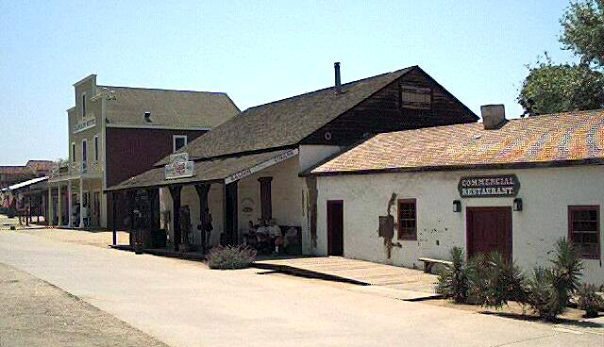Adventures & Explorations #4
Another one from Old Town San Diego in 2000. This is the part I like best - just wandering around town, imagining what it might have been like way back when it was a REAL town.
Here's 3 more interesting buildings. The "Commercial Restaurant" is actually La Casa de Machado y Silvas. The building next to it is "Racine & Laramie" (replica) and that 3-story building beyond is the "Colorado House" (another replica).
More info, mostly from https://www.parks.ca.gov/?page_id=2801 :
La Casa de Machado y Silvas
Built in the early 1840s, this rectangular adobe on the plaza was a wedding present from José Manuel Machado to his daughter, María Antonia, and her husband, José Antonio Nicasio Silvas. It had four rooms and three doorways that opened onto the plaza.
María Antonia converted the casa into the Commercial restaurant in the early 1850s. The Machado y Silvas family owned the property until the early 1930s. It was a rooming-house, café, art studio, souvenir shop, and community chapel before becoming part of California State Parks in 1968. It is one of the five historic adobes in the park.
Racine & Laramie (http://www.racineandlaramie.com/AboutUs.html )
In 1868 Racine & Laramie became San Diego's first cigar store. Having come from eastern Canada in the prosperity following the War Between the States, Messrs. Racine and Laramée sold cigars, tobacco, stationery, pipes, cutlery, and gentlemen's furnishings. The adobe they rented had been built in the 1820's as the retirement home for leather-jacket soldier Juan Rodriguez of the Royal Presidio.
It was one of the first six buildings in the small pueblo. At that time San Diego was home to 500 registered voters, and thousands of Kumeyaay. The Rodriguez family held ownership through periods of depression and the gold rush boom. Their son, Ramon, was on the city council. The widow Rodriguez had the building remodeled in 1867 and rented to Racine & Laramie and the Bank Exchange saloon. All was lost in the fire of 1872.
Using archeology, historic research and photographs this building has been reconstructed with the interior furnished and stocked as it may have been in that remote, frontier Pacific port.
Colorado House
The Colorado House was a hotel constructed and operated by Cave Johnson Couts, a lieutenant in the U.S. Army Dragoons. Controversy surrounded the hotel's construction and opening; it was rumored that Couts obtained the property illegally. Construction was completed in 1851, and the two-story hotel had a first-floor veranda and square-shaped false front. Additionally, the hotel boasted a "spacious and airy dining saloon" and billiard table.
In 1851, he married Ysidora Bandini, the daughter of his friend, Juan Bandini. Among the wedding gifts was a title to over 2,200 acres of property near San Luis Rey, where Couts built his family residence. Couts lost interest in the Colorado House due to preoccupation with his rancho, and leased the hotel in 1854.
Over the next 12 years, the building was renovated to provide office space for the San Diego Herald, a surgeon, jeweler, hairdresser, and other businesses. Couts sold the property to Joseph Mannasse and Marcus Schiller in 1866, and the building burned in the 1872 fire on San Diego Avenue.
California State Parks reconstructed the building in 1992, and it is now operated by Wells Fargo as a stage stop and telegraph office.
